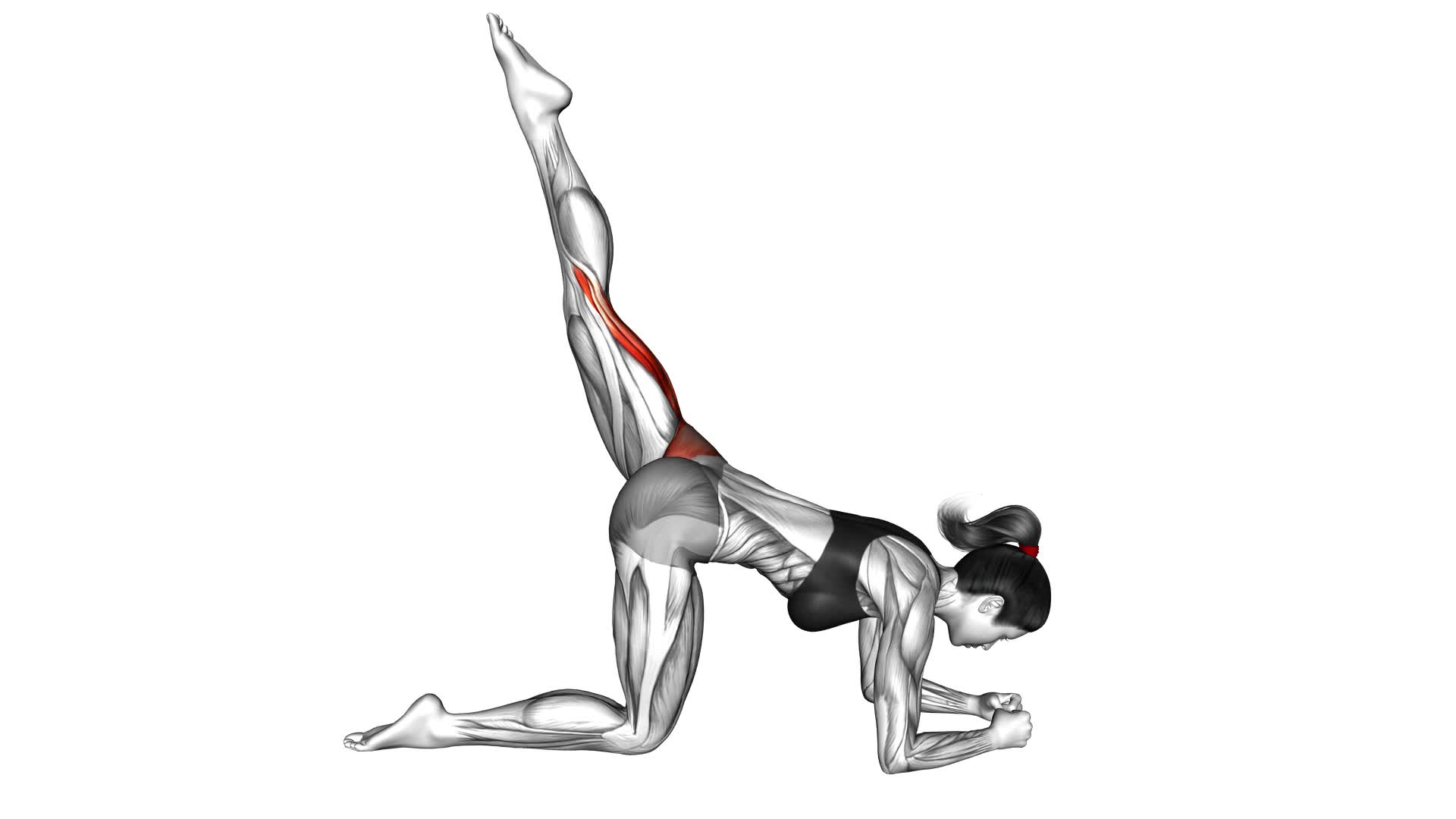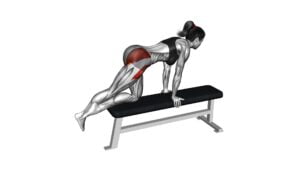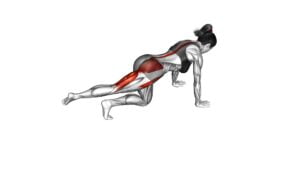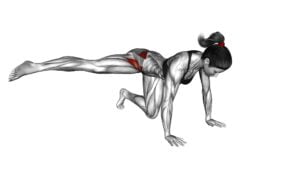Kneeling Leg Raise (female) – Video Exercise Guide & Tips

Looking to strengthen your legs and core? Try the Kneeling Leg Raise!
Watch This Exercise Video
This video exercise guide and tips will help you master the proper form and avoid common mistakes.
With variations to challenge yourself and tips for maximizing your workout, you'll be on your way to achieving your fitness goals.
So grab your mat and get ready to feel the burn with this effective exercise.
Let's get started!
Key Takeaways
- The kneeling leg raise engages and strengthens glutes and core muscles simultaneously.
- It improves overall stability, balance, and hip stability and power.
- Proper form and core engagement are essential to reduce the risk of injury and maximize effectiveness.
- Incorporating variations and modifications can increase the challenge and target specific muscle groups.
Benefits of the Kneeling Leg Raise
To fully reap the benefits of the Kneeling Leg Raise, you need to engage and strengthen your glutes and core muscles simultaneously. This exercise is an excellent way to build core strength and increase muscle activation in both your glutes and abdominal muscles. By performing the Kneeling Leg Raise, you can target these specific areas while also improving overall stability and balance.
Core strength is essential for maintaining proper posture, preventing lower back pain, and enhancing athletic performance. The Kneeling Leg Raise specifically targets the deep core muscles, such as the transverse abdominis, which are responsible for stabilizing the spine. This exercise also engages the gluteus maximus, the largest muscle in the buttocks, helping to improve hip stability and power during movements like running or jumping.
By incorporating the Kneeling Leg Raise into your workout routine, you can effectively strengthen your core while activating and toning your glutes. This exercise can be modified to increase or decrease the difficulty level based on your fitness level.
Now, let's move on to the equipment needed for the exercise.
Equipment Needed for the Exercise
Now let's talk about what equipment you'll need for the Kneeling Leg Raise exercise. The good news is that this exercise doesn't require any special equipment. All you need is a comfortable mat or a soft surface to kneel on. This will provide support and cushioning for your knees throughout the exercise.
If you don't have a mat or a soft surface, you can also use a folded towel or a yoga mat to protect your knees from any discomfort. It's important to prioritize your comfort and safety while performing this exercise.
In terms of modifications, there are a few options you can consider. If you find it challenging to maintain balance during the exercise, you can use a wall or a sturdy object to stabilize yourself. Simply place your hand on the wall or object for support while performing the leg raises.
Additionally, if you have any knee or lower back issues, you can modify the exercise by performing it while lying down on your side. This will alleviate any pressure on your knees and lower back, making it more comfortable for you.
Step-by-Step Instructions for Proper Form
To perform the Kneeling Leg Raise with proper form, follow these steps:
- Start by kneeling on a mat or soft surface with your knees hip-width apart and your hands placed on the floor in front of you for support.
- Engage your core by pulling your belly button in towards your spine. This will help create stability and protect your lower back during the exercise.
- Take a deep breath in and as you exhale, slowly lift one leg up, keeping it straight and parallel to the floor. Avoid any swinging or jerking motions.
- Pause for a moment at the top of the movement, focusing on squeezing your glutes and keeping your core engaged.
- Inhale as you lower your leg back down to the starting position in a controlled manner.
- Repeat the movement with the other leg.
- Continue alternating legs for the desired number of repetitions.
Remember to maintain proper breathing throughout the exercise and keep your core engaged for stability and control.
Now, let's move on to the next section where we'll discuss common mistakes to avoid during the Kneeling Leg Raise exercise.
Common Mistakes to Avoid
To ensure a safe and effective kneeling leg raise, it's important to avoid common mistakes that can hinder your progress. Incorrect form puts you at risk of injury, so make sure to maintain proper alignment throughout the exercise.
Engaging your core is crucial for maximum benefit, so be mindful of keeping your abdominal muscles engaged.
Additionally, don't forget to focus on your breathing, inhaling as you lower your leg and exhaling as you raise it.
Incorrect Form Risks Injury
Avoid these three common mistakes when performing the kneeling leg raise exercise to minimize the risk of injury.
First, ensure proper core activation throughout the movement. Engaging your core muscles not only helps to stabilize your body, but also maximizes the effectiveness of the exercise.
Second, avoid swinging your legs or using momentum to lift them. This reduces the workload on your muscles and increases the risk of strain or injury.
Lastly, be mindful of your form and avoid arching your back or hunching your shoulders. Maintain a neutral spine position and keep your shoulders relaxed.
By following these guidelines, you can perform the kneeling leg raise exercise safely and effectively.
Now, let's move on to the next section, which discusses the importance of engaging your core muscles during this exercise.
Lack of Core Engagement
Ensure proper core engagement to maximize the effectiveness of the kneeling leg raise exercise and prevent injury.
Core activation is essential during this exercise as it helps stabilize your spine and pelvis, allowing for proper movement and reducing the risk of muscle imbalances. A lack of core engagement can lead to compensatory movements, placing unnecessary strain on your lower back and hip flexors.
To activate your core, focus on drawing your belly button towards your spine and maintaining a neutral spine position throughout the exercise. This will help you maintain control and stability, allowing your leg muscles to work more effectively.
Neglecting proper core engagement can limit the benefits of the exercise and increase the risk of injury.
Now, let's move on to the next important aspect: neglecting proper breathing.
Neglecting Proper Breathing
Breathe deeply and rhythmically throughout the kneeling leg raise exercise to optimize your performance and avoid common mistakes.
Proper breathing techniques are crucial for engaging your core effectively during this exercise. When you inhale deeply, you allow your diaphragm to expand, creating a stable foundation for your movements.
As you exhale, focus on activating your core muscles, specifically your abdominals and lower back. This helps maintain stability and control throughout the exercise. Neglecting proper breathing can lead to a lack of core engagement, making the exercise less effective and potentially increasing the risk of injury.
Remember to breathe in a controlled manner, inhaling through your nose and exhaling through your mouth. By incorporating proper breathing techniques, you can maximize the benefits of the kneeling leg raise and improve your overall performance.
Variations to Challenge Yourself
To increase the difficulty of the kneeling leg raise exercise, you can incorporate challenging variations. These advanced modifications won't only challenge your core and hip muscles but also help you progress in your fitness journey.
One challenging variation is the weighted kneeling leg raise. Instead of just using your body weight, you can hold a dumbbell or a medicine ball between your ankles as you lift your legs. This added resistance will intensify the exercise and further engage your muscles.
Another variation is the single-leg kneeling leg raise. Instead of lifting both legs simultaneously, you can raise one leg at a time while maintaining your balance on the opposite knee. This modification requires more stability and control, making it more challenging for your core and glutes.
Additionally, you can try performing the kneeling leg raise on an unstable surface, such as a Bosu ball or a balance disc. This will require even more strength and stability as you try to maintain your balance while performing the exercise.
Remember to always start with the basic kneeling leg raise and gradually progress to these challenging variations. Listen to your body, and if you experience any pain or discomfort, stop the exercise immediately.
Incorporating these advanced modifications will help you take your kneeling leg raise to the next level and continue challenging yourself.
Tips for Maximizing Your Workout
To maximize your workout, it's important to focus on proper form techniques. Ensuring that you maintain correct posture and alignment will help target the intended muscles and prevent injury.
Additionally, incorporating effective breathing techniques, such as exhaling during the exertion phase and inhaling during the relaxation phase, can enhance your overall workout experience.
Proper Form Techniques
To ensure maximum effectiveness and prevent injury, you should focus on maintaining a strong and stable core while performing the kneeling leg raise exercise.
One common misconception about this exercise is that it primarily targets the leg muscles. However, proper form and technique are crucial for activating the correct muscle groups.
By engaging your core, you can enhance the overall effectiveness of the exercise and prevent strain on your lower back. To activate your core, imagine pulling your belly button towards your spine and maintaining a neutral spine position throughout the movement. This will help you maintain stability and control as you raise your leg.
Remember to breathe steadily and avoid any jerking or swinging motions. By focusing on proper form and engaging your core, you can maximize the benefits of the kneeling leg raise exercise.
Effective Breathing Techniques
Maintain optimal breathing techniques to maximize the effectiveness of your workout while performing the kneeling leg raise exercise. Proper breathing is essential in any exercise routine as it helps deliver oxygen to your muscles, allowing them to work efficiently and prevent fatigue.
To enhance your breathing during the kneeling leg raise, try incorporating specific breathing exercises and mindfulness techniques. Begin by taking deep breaths in through your nose and exhaling slowly through your mouth. This helps you relax and focus on your breath.
As you raise your legs, exhale and engage your core muscles. Inhale as you lower your legs back down. By practicing these breathing techniques, you can increase your concentration, enhance your body awareness, and improve the overall effectiveness of your workout.
Frequently Asked Questions
How Many Repetitions Should I Do for the Kneeling Leg Raise Exercise?
To determine the number of repetitions for the kneeling leg raise exercise, it's important to consider your fitness level and goals.
Start with a comfortable number, such as 10 repetitions, and gradually increase as you get stronger.
Progress by adding more reps or incorporating resistance bands or ankle weights.
Be mindful of common mistakes like arching your back or using momentum.
Focus on maintaining proper form and engaging your core throughout the exercise.
Can Men Also Perform the Kneeling Leg Raise Exercise?
Yes, men can also perform the kneeling leg raise exercise. It isn't exclusively for females.
Kneeling leg raises offer various benefits for men's fitness. This exercise targets the lower body muscles, including the glutes, hamstrings, and quadriceps. It can help improve leg strength, stability, and balance.
Incorporating kneeling leg raises into your workout routine can be a great way to enhance overall lower body strength and performance.
Is It Necessary to Warm up Before Doing the Kneeling Leg Raise Exercise?
Before performing the kneeling leg raise exercise, it's important to warm up your body. Incorporating warm up exercises before any workout has several benefits, including increasing blood flow to your muscles and preparing them for the upcoming activity. This can help prevent injuries and improve performance.
To prevent injuries during the kneeling leg raise exercise, make sure to maintain proper form, engage your core, and start with a manageable range of motion.
How Long Does It Take to See Results From the Kneeling Leg Raise Exercise?
To maximize the effectiveness of the kneeling leg raise exercise, it's important to perform it with the optimal frequency. Consistency is key, so aim to do the exercise at least 2-3 times a week.
Results can vary depending on your individual fitness level and goals, but with regular practice and proper form, you may start seeing improvements in strength and muscle tone within a few weeks.
Remember to listen to your body and gradually increase intensity as you progress.
Are There Any Modifications or Alternatives for People With Knee or Back Problems?
If you have knee or back problems, there are modifications and alternatives for the kneeling leg raise exercise.
You can try a seated leg raise or a lying leg raise instead. These exercises put less strain on your knees and back.
You may also consider using a stability ball or resistance bands to provide support and reduce the impact on your joints.
Remember to consult with a professional before starting any new exercise routine.
Conclusion
In conclusion, the kneeling leg raise is a great exercise for targeting and strengthening the muscles in the lower body, particularly the legs and glutes. By following the proper form and avoiding common mistakes, you can maximize the benefits of this exercise.
Additionally, incorporating variations into your routine can help challenge yourself and keep your workouts interesting. Remember to always listen to your body and consult with a professional if you have any concerns or questions.
Keep up the good work!

Author
Years ago, the spark of my life’s passion ignited in my mind the moment I stepped into the local gym for the first time. The inaugural bead of perspiration, the initial endeavor, the very first surge of endorphins, and a sense of pride that washed over me post-workout marked the beginning of my deep-seated interest in strength sports, fitness, and sports nutrition. This very curiosity blossomed rapidly into a profound fascination, propelling me to earn a Master’s degree in Physical Education from the Academy of Physical Education in Krakow, followed by a Sports Manager diploma from the Jagiellonian University. My journey of growth led me to gain more specialized qualifications, such as being a certified personal trainer with a focus on sports dietetics, a lifeguard, and an instructor for wellness and corrective gymnastics. Theoretical knowledge paired seamlessly with practical experience, reinforcing my belief that the transformation of individuals under my guidance was also a reflection of my personal growth. This belief holds true even today. Each day, I strive to push the boundaries and explore new realms. These realms gently elevate me to greater heights. The unique combination of passion for my field and the continuous quest for growth fuels my drive to break new ground.







